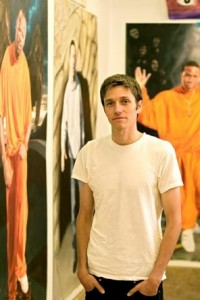Bissell ’05 Creates Interactive History of Freedom Installation

(Story contributed by Lily Baggott ’15)
West Coast artist Evan Bissell ’05 has a new project: “The Knotted Line.” Bissell, who holds a B.A. in studio arts and American studies from Wesleyan, was previously known for his work on What Cannot Be Taken Away: Families and Prisons Project, a series of portraits depicting prisoners and their loved ones.
The multimedia installation is an “interactive history of freedom and confinement in the geographic area of the United States from 1495 to 2025.” Available online, on smartphones, and in a print version, the project is designed for educational purposes in schools and community organizations and relies heavily on the users for further development.
“The Knotted Line is a participatory history. As it grows, it will include the works and perspectives of many people who use it,” Bissell says in a video explaining the project.
According to Bissell, the core of the project is the question of freedom: “Through a tactile webpage, paintings of fifty watershed historical moments, and multimedia resources, The Knotted Line helps uncover the roots of our current epidemic of incarceration and asks ‘How is freedom measured?’”
Bissell orients the project on the x, y, and z-axes. The x-axis consists of an interactive timeline, which uncovers a series of fifty miniature portraits created by the artist. Click on a painting and the y-axis, a conceptual, non-linear approach to history, appears. This includes discussion questions, lesson plans, and interactive responses. The third axis, or the z-axis, incorporates digital media, audio, images, and writing through the educators, students, and other visitors to the site.
“As an educational resource, the project brings one of the most pressing epidemics facing our country to the center through the x-axis, it encourages an approach to history that focuses on the active relevance of the past and the present through the y-axis, and inspires the practice of reimagining and self-determination through the participatory z-axis,” Bissell says.
The events included on the timeline span from 1495 to 2025, a total of 350 years. Speaking of the portion of the timeline that occurs in the future, Bissell told the online magazine Color Lines that this aspect is essential to the core idea of the project.
“So for me, it was really necessary to take all these things that are happening already and just imagine them growing into their capacity,” he says. “That was fun. And I think too, it’s really a way to theorize about our movements, and not in a way that is impossible.”
When asked by Color Lines about the name for the project, Bissell responded: “On the surface it relates to the contrasting uses of a knotted line – something that might be climbed to freedom or followed out of the Labyrinth – or something that could be used to confine and capture or kill.”
Prints from The Knotted Line were featured in the New World, New Sequence exhibit at the Yerba Buena Center for the Arts in San Francisco on Oct. 5.
View videos of Bissell online at: http://vimeo.com/49046156 and http://vimeo.com/50184018. Bissell was previously featured in this Wesleyan Connection article and this WesLive Community blog post.
Are you a Wesleyan alumnus? For more alumni stories, photo albums, videos, features and more, visit Wesconnect, the website for Wesleyan alumni.

